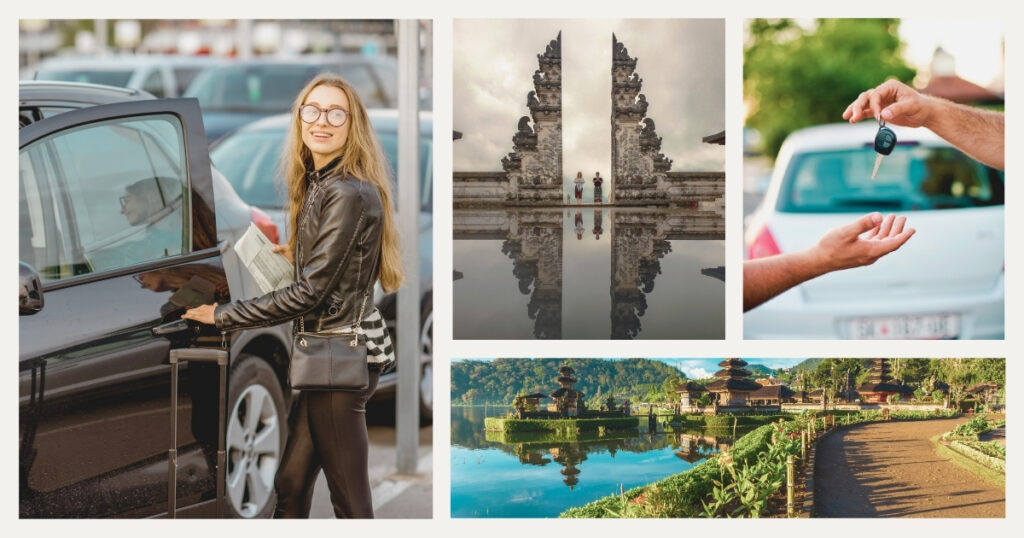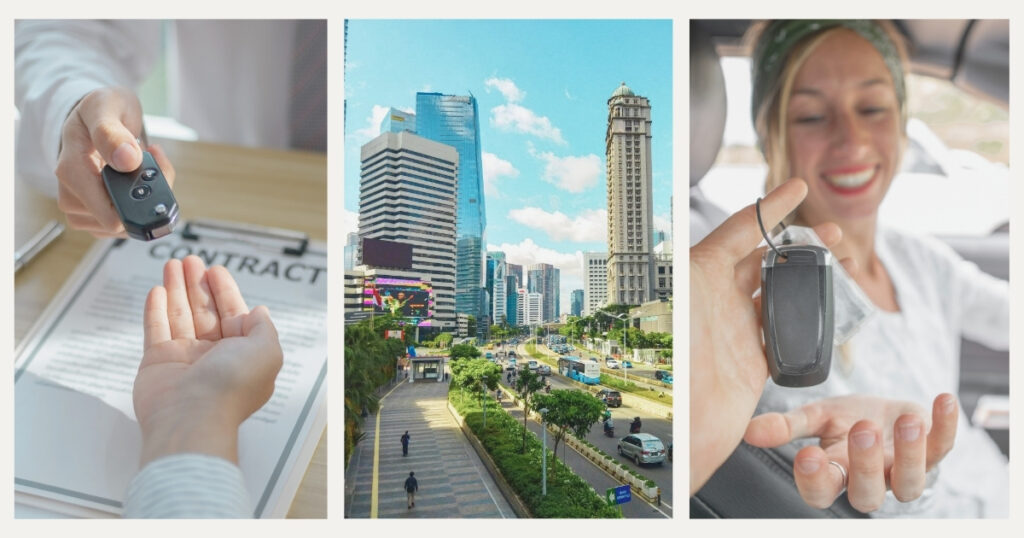Exploring Indonesia’s breathtaking archipelago as a digital nomad offers an unparalleled blend of tropical paradise and cultural immersion. With over 17,000 islands spanning three time zones, the freedom to rent a car in Indonesia transforms your experience from being confined to tourist hotspots to discovering hidden gems at your own pace, all while maintaining your remote work lifestyle.
Navigating the process to rent a car in Indonesia comes with unique considerations that differ significantly from Western countries. From understanding local driving customs to managing documentation requirements across islands like Bali, Java, and Sumatra, proper preparation ensures your Indonesian road adventure enhances rather than disrupts your digital nomad journey.
Let’s break down everything you need to know about renting and driving cars in Indonesia while balancing your remote work needs, helping you move confidently from booking to driving across this diverse archipelago nation.
Essential requirements to rent a car in Indonesia

Before embarking on your Indonesian road adventure, understanding the documentation and legal requirements will save you significant time and potential headaches at the rental counter.
Documentation and legal requirements
To rent a car in Indonesia, you’ll need a valid driver’s license from your home country, an International Driving Permit (IDP), your passport, and a credit card in the driver’s name. The IDP requirement is strictly enforced by reputable rental agencies and is legally mandatory for foreigners driving in Indonesia. Your IDP must be obtained before arriving in Indonesia, as they cannot be issued locally.
Most rental companies require drivers to be at least 21 years old, with a valid license held for a minimum of one year. Premium vehicle categories often have higher age requirements of 25 or even 30 years. Be prepared for rental agencies to place a substantial security deposit hold on your credit card, typically ranging from $300-$1,000 depending on the vehicle category.
🌟 Pro tip: even with an IDP, carry your original driver’s license at all times. Indonesian traffic police conduct frequent document checks, especially in tourist areas, and both documents must be presented together to be considered valid.
Insurance considerations for Indonesia
Understanding insurance options when you rent a car in Indonesia is crucial due to the unique driving conditions and traffic patterns. Basic Collision Damage Waiver (CDW) is typically included in standard rental packages but comes with high deductibles ranging from $500-$1,000. This basic coverage often excludes damage to tires, windshields, undercarriage, and side mirrors – components frequently damaged on Indonesia’s varied road conditions.
For comprehensive protection, consider purchasing “Super CDW” or “Full Protection” packages offered by rental agencies, which can reduce or eliminate the deductible and extend coverage to these vulnerable components. While this may increase your daily rate by 20-30%, it provides essential peace of mind, particularly if you plan to explore beyond main tourist areas where road conditions deteriorate significantly.
💡 Did you know? Indonesian car insurance typically doesn’t cover water damage, which is particularly relevant during the monsoon season (November to March) when flash flooding is common. If renting during this period, inquire specifically about flood damage coverage or avoid areas prone to flooding.
Navigating car rental options in Indonesia

Understanding where and how to rent a car in Indonesia can significantly impact both your budget and experience as a digital nomad exploring this vast archipelago.
Major rental companies vs. local providers
International rental agencies like Avis, Hertz, and Budget operate in Indonesia, primarily in Jakarta, Bali’s Denpasar, and other major city airports. These companies offer standardized booking processes, English-speaking staff, and newer vehicle fleets, but typically charge 30-50% more than local alternatives. Their primary advantage is the ability to book online with transparent terms and conditions.
Local Indonesian rental companies like TRAC, Express, and numerous small island-specific providers offer significantly lower rates and greater flexibility for long-term rentals. These local companies often provide better value for digital nomads planning extended stays, with potential discounts of 20-40% for weekly or monthly rentals. However, their booking systems may be less sophisticated, often requiring WhatsApp communication or in-person visits.
Island-specific rental considerations
Renting a car in Bali, Indonesia’s most popular digital nomad hub, offers the most straightforward experience with numerous options ranging from budget-friendly Suzuki Jimny 4WDs to premium Toyota Fortuners. Rates in Bali start around 250,000-350,000 IDR ($17-24 USD) daily for basic vehicles, with weekly rates offering 15-20% discounts. Automatic transmissions are readily available but command a 20-30% premium over manual options.
Java, particularly around Jakarta and Yogyakarta, presents different considerations with more congested urban driving but better highway infrastructure. Sumatra and Sulawesi offer spectacular driving opportunities but require more rugged vehicles and advanced planning, as rental options become limited outside major cities. Each island has distinct pricing patterns, with rates typically 10-15% lower outside Bali but fewer vehicle choices available.
🌟 Pro tip: if planning to rent a car in Indonesia for more than two weeks, negotiate directly with local providers rather than booking online. Many local agencies offer substantial discounts of 30-40% for direct bookings and can provide delivery and pickup services to your accommodation, saving you airport transfer costs.
Practical tips for driving in Indonesia

Successfully navigating Indonesian roads requires understanding local driving norms and preparing for unique challenges that many digital nomads may not anticipate.
Understanding Indonesian driving culture
Indonesian driving culture differs dramatically from Western norms, with seemingly chaotic traffic patterns that follow their own unwritten rules. Lane discipline is often treated as a suggestion rather than a requirement, and vehicles frequently create impromptu lanes during congestion. Traffic signals and signs exist in major cities but may be treated as advisory by local drivers, particularly regarding right-of-way at intersections.
Motorbikes comprise approximately 85% of vehicles on Indonesian roads and weave through traffic from all directions. As a car driver, constant vigilance for motorbikes is essential, particularly when turning or changing lanes. The unofficial hierarchy on Indonesian roads places larger vehicles at the top, meaning buses and trucks often expect smaller vehicles to yield regardless of formal right-of-way rules.
Connectivity solutions for remote work on the road
Maintaining reliable internet connectivity is crucial when you rent a car in Indonesia as a digital nomad, especially when working between destinations. Indonesian mobile networks offer variable coverage, with excellent service in tourist areas but significant gaps in rural regions and between islands.
A reliable eSIM solution from Holafly provides consistent connectivity throughout your Indonesian journey without the hassle of purchasing multiple local SIM cards as you move between islands. Their Indonesia-specific data plans ensure you can handle video calls, upload deliverables, and navigate accurately whether you’re exploring Bali’s rice terraces or Java’s volcanic landscapes.
Navigation and route planning strategies

Google Maps works reasonably well in Indonesian urban areas but becomes less reliable in rural regions. Download offline maps before venturing into remote areas, and consider supplementing with apps like Waze (excellent for urban traffic) or Maps.me for better offline functionality. Road signage is predominantly in Bahasa Indonesia, so familiarize yourself with key terms like “Jalan” (road), “Keluar” (exit), and “Dilarang” (prohibited).
Plan journeys conservatively, as travel times in Indonesia frequently exceed mapping app estimates by 30-50% due to unpredictable traffic, road conditions, religious processions, and weather impacts. A 100km journey that might take one hour in Western countries can easily require 2-3 hours in Indonesia, particularly outside major highways. Build buffer time into your schedule, especially when you have remote work commitments.
Key considerations when driving in Indonesia:
- Indonesians drive on the left side of the road
- Right-hand vehicles are standard
- Fuel is called “Bensin” (gasoline) or “Solar” (diesel)
- Speed limits are 80-100 km/h on highways, 40-60 km/h in urban areas
- Seatbelts are mandatory but often not enforced
- Traffic police can demand on-the-spot fines for violations
- Most toll roads require cash payment in Indonesian Rupiah
- Parking attendants expect small tips (2,000-5,000 IDR) even at official lots
- Flash flooding can occur suddenly during the rainy season
🌟 Pro tip: consider hiring a local driver for your rental car in metropolitan areas like Jakarta or during your first few days in a new Indonesian region. This typically costs 350,000-500,000 IDR ($24-35 USD) per day but provides valuable insight into local driving patterns and navigation while allowing you to focus on work during transfers between destinations.
Final thoughts on renting a car in Indonesia
The decision to rent a car in Indonesia as a digital nomad offers unparalleled flexibility to blend productive work time with authentic exploration of this diverse archipelago. While the driving experience presents challenges that differ significantly from Western countries, the reward of discovering hidden waterfalls in Bali, ancient temples in Java, or pristine beaches in Lombok at your own pace makes the effort worthwhile.
The freedom to create your own schedule allows digital nomads to optimize productivity by working during midday heat or traffic congestion while exploring during off-peak hours. This flexibility transforms what might be wasted time into valuable work sessions, creating a more balanced nomadic experience than relying solely on scheduled transportation options.
With proper preparation, realistic expectations about traffic and road conditions, and the right connectivity solutions, renting a car in Indonesia can enhance both your professional productivity and personal experience as a digital nomad in this breathtaking country of islands.
Ready to explore Indonesia’s stunning archipelago while maintaining your remote work lifestyle?
Nomada offers comprehensive resources for digital nomads balancing productivity and adventure across Southeast Asia’s most diverse country.
Your Indonesian road adventure awaits with Nomada 👉
Frequently asked questions about renting a car in Indonesia
Yes, foreigners can legally drive in Indonesia with a valid home country driver’s license AND an International Driving Permit (IDP). Both documents must be carried together at all times, as neither is valid alone. The IDP must be obtained in your home country before arrival in Indonesia.
Rental prices vary significantly by island and vehicle type. Basic cars start around 250,000-350,000 IDR ($17-24 USD) per day in Bali, with weekly rates offering 15-20% discounts. Premium SUVs range from 700,000-1,500,000 IDR ($48-105 USD) daily. Prices are typically 10-15% lower in Java and other islands but selection may be limited.
Hiring a driver is highly recommended for first-time visitors and in congested cities like Jakarta and Surabaya. Driver services typically cost 350,000-500,000 IDR ($24-35 USD) per day, including the driver’s meals. This option allows you to work productively during transfers while navigating challenging traffic conditions safely.
SUVs or crossovers with higher ground clearance are ideal for Indonesia’s varied road conditions, particularly outside major cities. Popular options include the Toyota Avanza, Rush, or Fortuner. On smaller islands like Bali, compact SUVs like the Suzuki Jimny offer good maneuverability while handling rough roads better than sedans.
Most rental agreements prohibit taking vehicles on inter-island ferries without prior permission. If island-hopping is part of your plan, arrange this specifically with your rental provider beforehand. Additional insurance and documentation are typically required, and not all companies permit this use.




